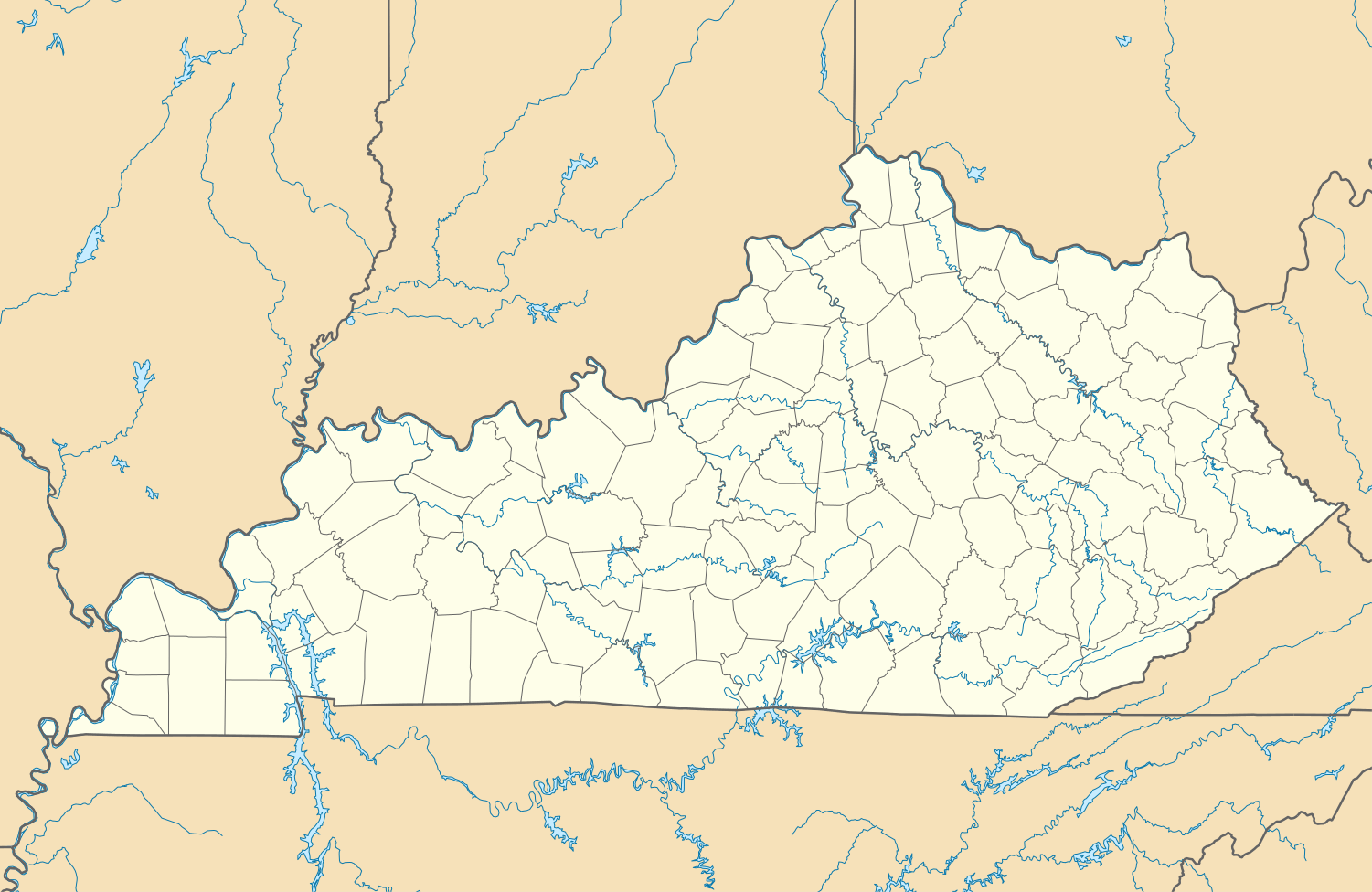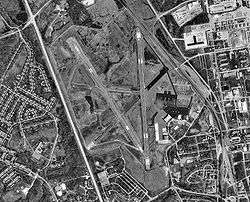Godman Army Airfield
| Godman Army Airfield | |||||||||||||||||||||||
|---|---|---|---|---|---|---|---|---|---|---|---|---|---|---|---|---|---|---|---|---|---|---|---|
|
USGS aerial image, 29 March 1998 | |||||||||||||||||||||||
| IATA: FTK – ICAO: KFTK – FAA LID: FTK | |||||||||||||||||||||||
| Summary | |||||||||||||||||||||||
| Airport type | Military | ||||||||||||||||||||||
| Owner | United States Army | ||||||||||||||||||||||
| Location | Fort Knox, Kentucky | ||||||||||||||||||||||
| Elevation AMSL | 756 ft / 230 m | ||||||||||||||||||||||
| Coordinates | 37°54′25″N 085°58′20″W / 37.90694°N 85.97222°W | ||||||||||||||||||||||
| Runways | |||||||||||||||||||||||
| |||||||||||||||||||||||

Godman Army Airfield (IATA: FTK, ICAO: KFTK, FAA LID: FTK) is a military airport located on the Fort Knox United States Army post in Hardin County, Kentucky, United States. It has four runways and is used entirely by the United States Army Aviation Branch.
History
Godman Army Airfield was established about October 1918 for the 29th Aero Squadron for World War I at then Camp Knox United States Army Air Corps. Its initial mission was to support Army forces at Fort Knox. In the build-up of the Army prior to the United States' entry into World War II and the establishment of the United States Army Air Forces, the 73d Observation Group was established at the airfield in November 1941, assigned to First Air Force. The 73d's mission was to train and provide tactical reconnaissance in support of Army maneuvers.
After the United States entered World War II, Godman AAF became a First Air Force group training station for B-25 Mitchell medium bomber groups. The 387th and 391st Bombardment Groups formed and trained at Godman in 1943 prior to their overseas deployment.
In 1944, the mission changed to replacement training, and the 477th Bombardment Group became the B-25 Replacement Training unit. It trained replacement personnel prior to their reassignment to combat units overseas. It remained at Godman after World War II, and the airfield was designated as a permanent station of the USAAF.
In 1946, Godman was reassigned to the Tenth Air Force as part of the Air Force Reserve. The 315th Army Air Force Base Unit became the host organization, and the 477th Bomb Group remained as the flying organization until its inactivation in October 1946. Redesignated as the 315th Air Force Base Unit in September 1947 with the establishment of the United States Air Force, it was further redesignated as the 2236th Air Force Reserve Training Center in July 1948. Concurrently, Godman Field was renamed Godman Air Force Base.
On October 10, 1950, during the Korean War, President Harry S. Truman placed the Kentucky Air National Guard's 123d Fighter-Bomber Group on active duty and moved the unit from Standiford Field to Godman Field. The airfield was then reassigned to Tactical Air Command. The unit's P-51 Mustangs were ferried to the Far East, and several of the unit's pilots volunteered for combat duty over Korea.
In addition to the Kentucky ANG, the New Jersey ANG's 108th Fighter-Bomber Wing was federalized and brought into active service on 1 March 1951, was assigned to Strategic Air Command's 40th Air Division at Turner AFB, Georgia. In its activated configuration, the wing was composed of the 141st Fighter Squadron of the New Jersey Air National Guard, the 149th Fighter Squadron of the Virginia Air National Guard and the 153rd Fighter Squadron of the Mississippi Air National Guard. During its federal service period, the wing trained to conduct long range bombardment escort missions. On 9 December 1951, the wing was reassigned to Godman AFB. It was relieved from active service on 1 December 1952 and returned to the control of the New Jersey ANG.
After the 1953 armistice in Korea, Godman was phased down and the 4430th Air Base Wing became the host organization at the base. Air Force activities were ended and the base was inactivated on 31 December 1953. It was subsequently transferred to the United States Army and became a light aircraft and helicopter airfield in support of Fort Knox, renamed as Godman Army Airfield.
UFOs: Mantell Incident
The Thomas Mantell incident began at 1:20pm on 7 January 1948, when the control tower operators at Godman Army Airfield, Kentucky sighted an unidentified airborne object in the sky close to the base. Several senior officers were summoned, and the base Operations and Intelligence Officer were soon joined by the Commanding Officer, but none were able to identify the object.
At the time a flight of four P-51 fighters was on a routine training flight under the supervision of Flight Commander Captain Thomas Mantell. They were flying towards Godman Field when, at approximately 2:45pm, the control tower officer in charge ordered them to investigate the strange object. Captain Mantell acknowledged, but a short time later one of the pilots requested permission to break away as he was running low on fuel, leaving the three remaining aircraft to head in the direction of the strange object.
The next message came from one of the three remaining pilots, who said he was losing his bearings and was becoming fearful of becoming lost. He too was granted permission to break away and return, but he would be accompanied by one of the two remaining pilots, who was instructed to accompany his colleague to guide him safely back to base. The only aircraft now in pursuit of the object was that piloted by Captain Thomas Mantell.
At 15,000 feet Mantell contacted the control tower and stated that he had the object in sight and was climbing to investigate. A short time later Mantell reported that he was closing on the object but that was the last message broadcast. Mantell's aircraft crashed approximately 90 miles south of Godman Field.
The official Air Technical Information Command report on the crash stated that they were of the opinion that Captain Mantell lost consciousness due to oxygen starvation. The trimmed aircraft had continued to climb until increasing altitude caused a sufficient loss of power for it to level out. The aircraft then began to turn left due to torque and as the wing drooped, so did the nose, until it was in a tight turning spiral. The uncontrolled descent resulted in excessive speed causing the aircraft to disintegrate. It is believed that Captain Mantell never regained consciousness. This was borne out by the fact that the canopy lock was still in place after the crash, discounting any attempt to abandon the aircraft. They also stated that the UFO was in no way responsible for the crash.
See also
References
![]() This article incorporates public domain material from the Air Force Historical Research Agency website http://www.afhra.af.mil/.
This article incorporates public domain material from the Air Force Historical Research Agency website http://www.afhra.af.mil/.
- ↑ FAA Airport Master Record for FTK (Form 5010 PDF), effective 2008-06-05
External links
- Godman Army Airfield at GlobalSecurity.org
- Resources for this U.S. military airport:
- FAA airport information for FTK
- AirNav airport information for KFTK
- ASN accident history for FTK
- NOAA/NWS latest weather observations
- SkyVector aeronautical chart for KFTK



.jpg)